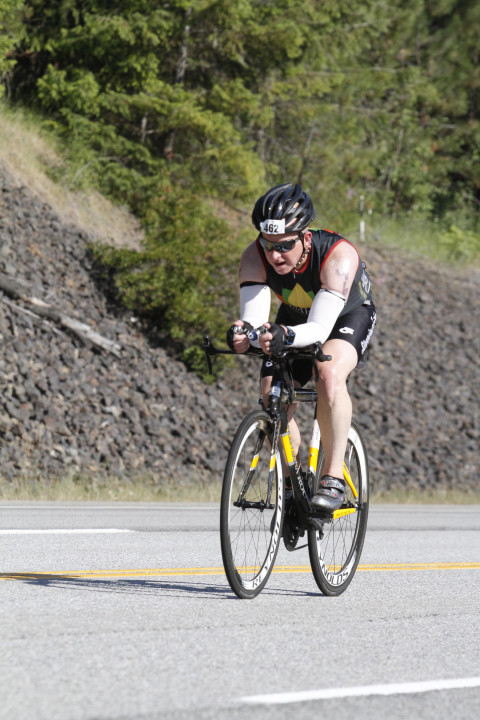 Several people have asked me how Ironman Coeur d’Alene compares to Ironman Lake Placid, namely the bike courses. So, I decided to attempt to answer that question with a bit of a comparison of the data that I accumulated from the last two races. It was fairly difficult to find any one tool that conclusively compared the two courses, so I used a few different methods. It is a bit off-the-cuff, but it might help to give some people a little idea of how similar or different these coursed really are.
Several people have asked me how Ironman Coeur d’Alene compares to Ironman Lake Placid, namely the bike courses. So, I decided to attempt to answer that question with a bit of a comparison of the data that I accumulated from the last two races. It was fairly difficult to find any one tool that conclusively compared the two courses, so I used a few different methods. It is a bit off-the-cuff, but it might help to give some people a little idea of how similar or different these coursed really are.
First off, I tried using Garmin Connect. While it is pretty easy to select two rides and click compare in GC, having IMCdA recorded as a “Multisport Activity” from my Garmin 920xt proved more difficult to compare since IMLP 2014 was recorded as just a single ride. Then I had to export the IMCdA Ride as a TCX file from the MultiSport activity and re-import it again by itself. When I did that, it didn’t calculate my Normalized Power watts at all and my average watts were off by about 3 watts. I then filled them in manually. So I finally got them in a table format which is below.
So, these courses above look very similar. The only major differences was my power output for Coeur d’Alene was about 20 watts less on average and normalized power. Note that I used the same Stages Power Meter for both races. The corrected elevations here show only 400 more feet of climbing at Lake Placid and about 500 more feet of loss as well.
Next I jumped over to Strava where I have the Stravistix extension which provides some more information on the grade of the courses. Thanks to the Stravistix Google Chrome Extension for Strava from Thomas Champagne for the statistics below…
IMCdA 2015
IMLP 2014
Here again, the courses are very close. The only thing that really stood out to me was that IMCdA has a little more flats and IMLP has a little more downhill.
Equalizing Course Profiles at 0 Elevation
I also was able to import the original Garmin FIT files into Golden Cheetah, which allowed me to the export the raw data points from each ride/course into a spreadsheet. I then imported those rides into my favorite analysis tool, QlikView.
I equalized the starting elevations for each course to zero for each race profile. Next, I adjusted the rest of the points elevations’ by the difference from that starting elevation to zero. Plotting this way then moves the course profiles on top of one another(below) as if they started at exactly the same elevation. This gives us a interesting perspective of the courses that I would not have seen looking at the numbers above. While the numbers look the same the profiles are very different.
The Coeur d’Alene course is much more up-and-down in the range of 0-500′ climbing. Lake Placids’ long downhill section into Keene provides you with a nice long and speedy descent, but then you pay for that later with the very a very long, gradual climb from Jay all the way back to Lake Placid. This climb continues on into your second loop at LP too after heading through town. So if you like a constant gradual climbing then Lake Placid is more your style, whereas CdA is more for the folks who like big rollers.
The one thing I didn’t take into account here was the wind. For Ironman Coeur d’Alene 2015, the wind was coming out of the NNE mostly at around 7 MPH. This provided a nice tailwind from mostly the first turnaround at Heggins Point all the way out to the second turnaround. Coming back to town thought was obviously a headwind. Not a bad one, but I could definitely feel it. Lake Placid in 2014 was a little higher at around 8+ MPH out of the South. It always seems to just whip right up through the Wilmington Notch as you are grinding your way back to Lake Placid. 2014 also had a the nice edition of nasty thunderstorm on the first half of the first loop too.
EFD -Effective Flat Distance Overall
For one last comparison, I had stumbled upon the Flacyclist.com site by Tom Jordan. Tom has a calculator tool he put together that figures our what the Effective Flat Distance(EFD or EDO) of a ride is. This is basically how long the ride would be if you took into account the climbs and descents and just flatten everything out. It seems pretty complicated, but probably a more accurate way to equalize different courses for comparison.
I downloaded Toms’ spreadsheet version of the calculator and filled in the data. Getting some of the required fields tooks some data wrangling. I used the ride extract from Golden Cheetah and then did some Excel magic to figure out the climbing(> 1%)/descending(< -1%) distances. I had also downloaded hisorical weather info from Weather Underground site. I used some default values for area of rider and things like that. I set the wind direction at 45 since both courses were basically out-and-backs so there was a combination of headwind and tailwind. You can view the calculations here…
Looking at the two course calculations above, you can see the (EDO or EFD)Effective Overall Distance for each ride is in the 2nd to last row of each image above. The first distance value is taking wind into consideration the other is not. Based on the no wind calculations here, the IMLP was equal to about 121 miles in EFD but the IMCdA course was just a couple miles more at 123 giving it a very slight edge in difficulty. But not much
Taking the wind into consideration, IMLP 2014 averaged about a mile or so more per hour(8.24mph) over the time on the bike course than IMCdA 2015(7.4mph). With an equivalent amount of head vs tailwind, this effectively evens both the courses out at about 142 miles and some change.
This comparison also seems to point to both courses being very comparable in difficulty. The only difference being what type of ride do you prefer? Do you like to maintain a steady uphill climb over a long distance or do you prefer more shorter ups-and-downs?
Personally I liked both courses in their own way I guess. I really feel like I could have PR’d the Coeur d’Alene course under normal temperatures this year. Once that heat kicked in, the wheels just fell off. Despite that I was still able to come in only 5 minutes later than Lake Placid the following year. I was under 3 hours for the first 56 miles while the temperatures were still reasonable.
I hope that was somewhat helpful to anyone considering either of those races. They are now moving the full Ironman in Coeur d’Alene to August next year, so 90-100 degree temperatures may be the norm for that race now. Some locals told me that that weather is more typical at that time of year there. That pretty much takes that off my list of races to try again! Hopefully next year I can compare the Ironman Mont-Tremblant course to these two courses.
Thanks!







2 comments
2 pings
There’s another website that you might want to look at to compare your data called GraphMyRun.com. I wrote it to help analyze my running data (so it will show min/mile instead of mph) but the analysis tab has some interesting graphs that might be of use. By the end of the year I’ll finish GraphMyBrick which will do a better job with cycling data.
By the way, a very interesting article so thanks. I’m signed up for IMLP for 2016 and I’m trying to learn as much about the course as possible. I ran the Tupper Lake Tinman this year and now I’m leary of the Adirondack hills. 😉
Phil
Author
Awesome Phil Thanks! I will definitely check it out. I would like to compare the run courses too, so I can use your site for that. Congrats on Lake Placid! Hills are manageable.
[…] I kind of fell off the blogging wagon a bit here lately(again). In my defense, IMLP vs IMCdA post took a bit of time to put together and I also needed to put together my next monthly post for […]
[…] temperature range. The reason I chose IMCdA was due to its’ typically cooler weather and the similarity of terrain to Ironman Lake Placid. What I got was something totally […]